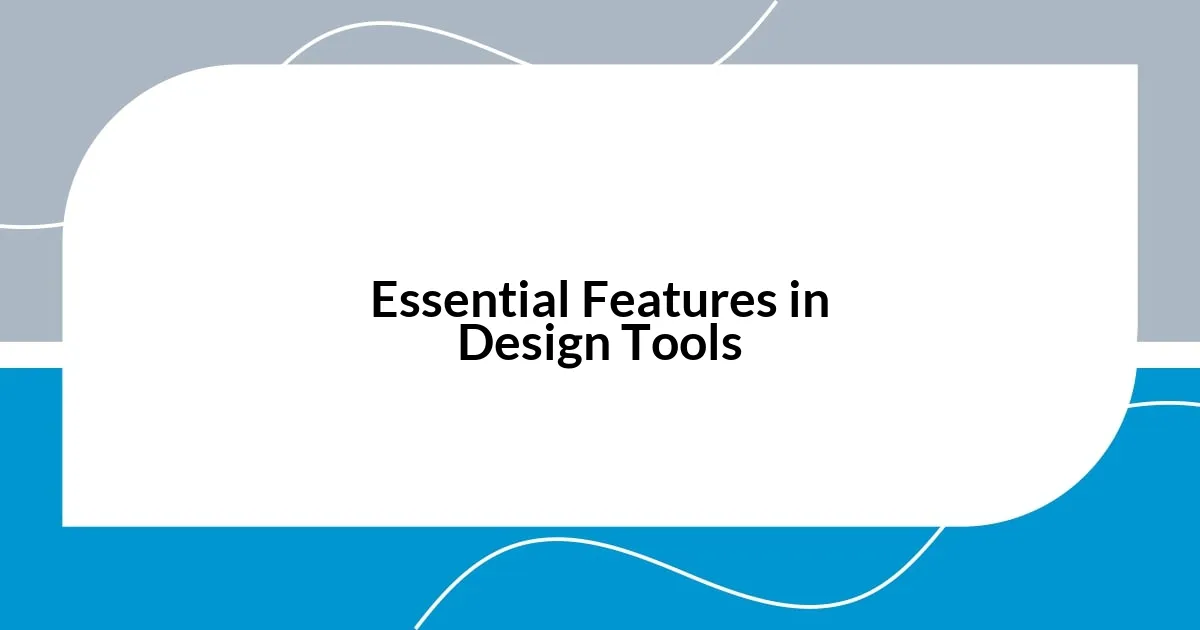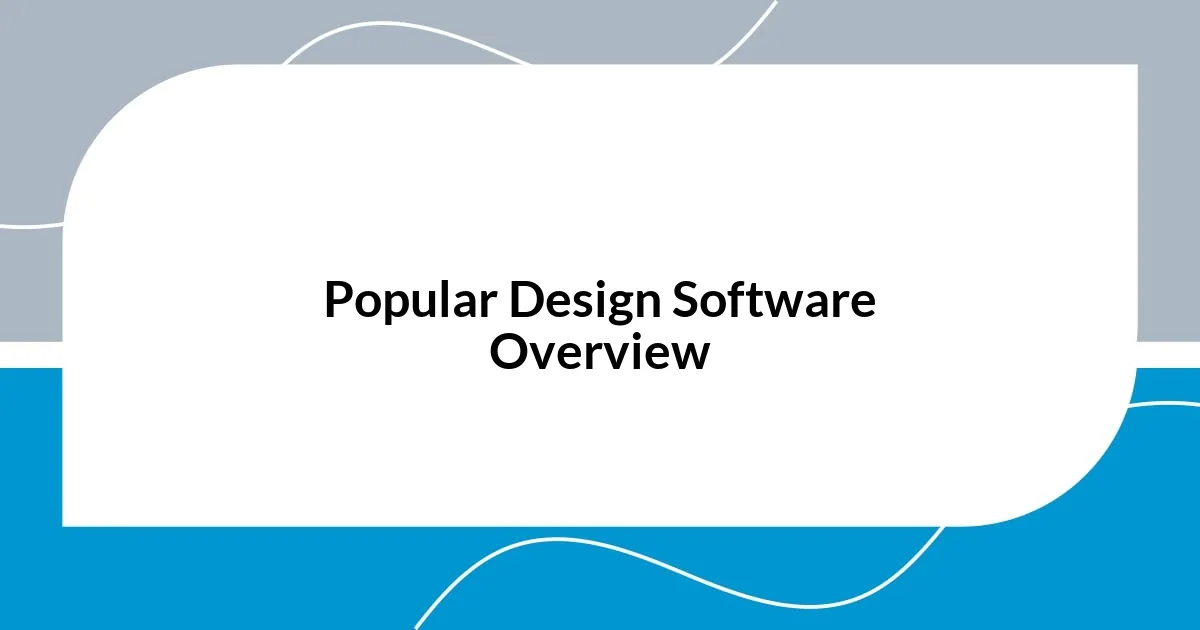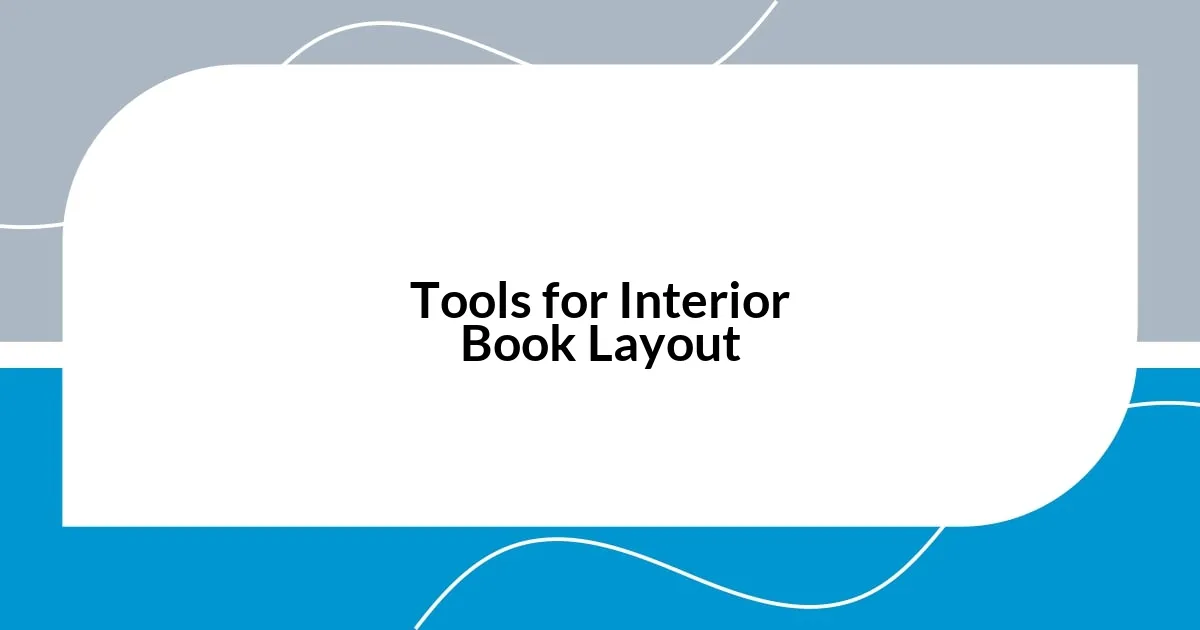Key takeaways:
- User-friendliness and versatility are crucial features in design tools, allowing for creativity without hindrance.
- Popular design software like Adobe InDesign, Canva, and Affinity Publisher cater to different skill levels and needs.
- Utilizing online resources like graphic libraries and design courses can significantly enhance one’s design skills and creative process.
- Choosing design tools should be based on comfort, long-term usability, and the ability to adapt to evolving needs.

Essential Features in Design Tools
When evaluating design tools for books, I always look for user-friendliness as a top feature. There’s nothing more frustrating than a complex interface that stifles creativity. I remember the first time I opened a design tool that was overly complicated; I spent more time searching for functions than actually designing. It made me think: how can you create something beautiful if the tool itself is a barrier?
Another essential feature is versatility in design elements. I find it incredibly useful when a tool offers a wide array of templates, fonts, and color palettes. For instance, when I was working on my last book cover, I was able to mix and match elements in a way that really brought my vision to life. Isn’t it exciting to have that kind of creative freedom at your fingertips?
Collaboration capabilities are also critical. I cherish the moments when I can seamlessly share my designs with a colleague for feedback without sending countless email attachments. The ability to collaborate in real time transforms the design process, making it feel more like a partnership. Have you ever experienced that ‘aha!’ moment when a simple suggestion from someone else elevates your design? It’s those interactions that remind me of the power of teamwork in the creative journey.

Popular Design Software Overview
When exploring popular design software for books, I can’t help but appreciate how each tool caters to different creative needs. For example, Adobe InDesign stands out for its professional features and print-ready outputs. I remember the satisfaction I felt when I designed my first book layout using InDesign. The grid systems and precise typography options elevated my work and made it look polished and professional.
On the other hand, Canva offers a more accessible experience, especially for those who might not have a design background. I know someone who created a stunning eBook cover in just a couple of hours using Canva’s intuitive drag-and-drop interface. It’s amazing how easily someone can take their ideas from concept to reality without spending a ton of time learning technical skills.
Finally, Affinity Publisher has been gaining popularity due to its affordability and robust features. I recall experimenting with it during a personal project, and I was pleasantly surprised by how it rivaled some of the more expensive software options. It feels great to discover options that provide value without breaking the bank.
| Software | Key Features |
|---|---|
| Adobe InDesign | Professional typesetting, advanced layout features |
| Canva | User-friendly, quick templates, drag-and-drop interface |
| Affinity Publisher | Affordable, powerful design capabilities |

Tools for Interior Book Layout
When it comes to interior book layout, I’ve found that the right tools can really make or break the design experience. I remember the first time I laid out a manuscript. I used Adobe InDesign, and the feeling of placing text and images just right was exhilarating. The tool’s precision made it easy to create a cohesive look that flowed beautifully across the pages. It was almost like orchestrating a symphony where every element had its part to play.
Here are some of my favorite tools for interior book layout:
- Adobe InDesign: Best for advanced users, offering precise control over typography and layouts.
- Scrivener: Perfect for writers looking to organize chapters and segments before layout.
- Microsoft Word: Surprisingly effective for simpler layouts; the familiarity can ease the design process.
- Affinity Publisher: Great for budget-conscious designers, with solid features that rival more expensive tools.
- Vellum: An excellent choice for authors focused on eBooks, known for its intuitive templates and streamlined export options.
Although not all tools are created equal, I often recommend starting with what feels comfortable to you. I once tried a new software that promised a myriad of features, but it left me overwhelmed. I ended up reverting to InDesign because its capabilities and my familiarity gave me the freedom to focus on creativity rather than troubleshooting. Each project teaches me something new about my preferences and the tools that truly resonate with my workflow.

Utilizing Online Design Resources
Utilizing online design resources can really enhance your creative process. I vividly remember the day I stumbled upon various design communities and resources online. The forums and tutorials opened up a treasure trove of knowledge. It felt as if a weight had been lifted off my shoulders; I wasn’t alone in my design struggles. Tips and tricks shared by fellow designers helped me refine my skills quickly, and I often ask myself, “What would I have done without those resources?”
One of my go-to strategies has been to explore free graphic libraries online. I can’t count how many times I’ve discovered the perfect vector graphic or stock image just by browsing platforms like Unsplash or Pexels. A few simple searches often reveal gems that elevate my projects in minutes. The best part? I get to support my work with high-quality elements without stretching my budget.
Another invaluable resource is online course platforms. I enrolled in a design course on Skillshare last year, and it completely reshaped my approach. The instructor’s hands-on sessions made me realize the power of color theory, which I previously overlooked. Have you ever had a moment where you learned something that clicked instantly? That feeling of growth is contagious, and it reminds me that there’s always room for improvement, no matter your skill level.

Tips for Choosing Design Tools
When choosing design tools, consider your comfort level first. I remember switching from a complex graphic design application to a simpler one, and it was like moving from a maze to a clear path. The intuitive interface of the new tool allowed me to focus on my creativity instead of getting lost in buttons and settings. Have you ever felt that sense of relief when a tool just clicks with you?
Take the time to explore different software and try out their free trials. For instance, I played around with various layout programs until I found one that felt just right. The thrill of discovering features that made my process smoother was genuinely satisfying. It’s like trying on clothes; what looks good on the rack may not fit well after all. What are the features you think are non-negotiable in your design toolkit?
Lastly, always think about your long-term projects. I once selected a tool based on its trendy features, only to realize a few months in that it lacked essential capabilities for my evolving needs. I learned that investing in a tool that can grow with you pays off in spades. Think of it as planting a tree; you want something sturdy that will flourish over time. Have you considered how your design preferences might change as you take on new projects?